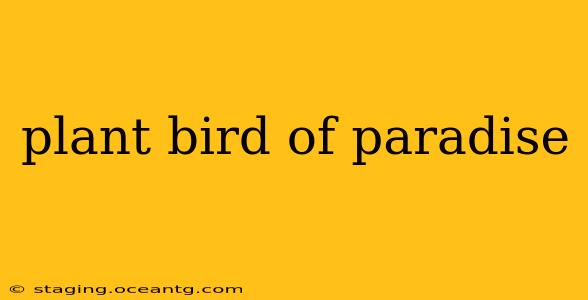The Bird of Paradise flower, with its vibrant, exotic blooms, is a coveted addition to any garden. But successfully planting and nurturing this stunning plant requires understanding its specific needs. This comprehensive guide will walk you through everything you need to know about planting Bird of Paradise, from choosing the right location and soil to ongoing care and maintenance.
What is the best time to plant a Bird of Paradise?
The best time to plant a Bird of Paradise is during the warmest months of the year, typically spring or early summer. This allows the plant ample time to establish its roots before the onset of colder weather. Planting in spring or early summer ensures the plant receives plenty of sunlight and warmth, crucial for healthy growth and establishment. Avoid planting during frost or freezing temperatures, as this can severely damage or kill the plant.
How do you plant a Bird of Paradise from seed?
While propagation from seed is possible, it's a lengthy process and not the most reliable method for home gardeners. It can take several years for a Bird of Paradise grown from seed to flower. Furthermore, seedlings are susceptible to diseases and pests. For quicker results and higher success rates, consider purchasing established plants from a reputable nursery.
How do you care for a Bird of Paradise plant?
Caring for a Bird of Paradise involves providing the right environment and consistent attention. Here's a breakdown:
Sunlight:
Bird of Paradise thrives in full sun to partial shade. At least six hours of sunlight daily is ideal, but some afternoon shade in hotter climates is beneficial to prevent leaf scorch.
Watering:
Water deeply and regularly, especially during the growing season (spring and summer). Allow the soil to dry slightly between waterings, avoiding soggy conditions which can lead to root rot. Reduce watering frequency in the fall and winter months.
Soil:
Well-draining soil is crucial. Bird of Paradise doesn't tolerate soggy conditions. A sandy loam mix amended with organic matter is ideal. Ensuring good drainage prevents root rot, a common problem for these plants.
Fertilizing:
Feed your Bird of Paradise regularly during the growing season with a balanced, slow-release fertilizer. Avoid over-fertilizing, as this can harm the plant. A balanced granular fertilizer applied every few months, or a liquid feed every couple of weeks, will provide the necessary nutrients for healthy growth and abundant blooms.
Pruning:
Pruning is minimal. Remove any dead or damaged leaves or stems as needed to maintain the plant's overall health and appearance. Avoid excessive pruning, as it can stress the plant.
What type of soil does a Bird of Paradise need?
As mentioned earlier, well-draining soil is paramount. A soil mix that is too heavy and retains too much water will lead to root rot and ultimately kill the plant. A sandy loam soil amended with compost or other organic matter offers the perfect balance of drainage and nutrient retention.
How often should you water a Bird of Paradise plant?
Watering frequency depends on several factors, including climate, soil type, and pot size (if potted). Generally, aim to water deeply but infrequently, allowing the top inch or two of soil to dry out between waterings. Overwatering is a far greater risk than underwatering. Check the soil moisture regularly by sticking your finger into the soil a couple of inches; if it feels dry, it's time to water.
What is the best fertilizer for a Bird of Paradise plant?
A balanced fertilizer is ideal, offering equal proportions of nitrogen, phosphorus, and potassium (N-P-K). A slow-release granular fertilizer is convenient and provides a consistent supply of nutrients. Alternatively, a liquid fertilizer can be applied every few weeks during the growing season. Always follow the package instructions carefully to avoid over-fertilizing.
How big do Bird of Paradise plants get?
The size of a mature Bird of Paradise plant varies depending on the species and growing conditions. Some varieties can reach heights of 6-8 feet, while others may stay smaller, particularly when grown in containers. Providing ample space and appropriate care will encourage larger growth.
By following these guidelines, you can successfully plant and nurture your own stunning Bird of Paradise, enjoying its vibrant blooms for years to come. Remember, patience and consistent care are key to success with this magnificent plant.
